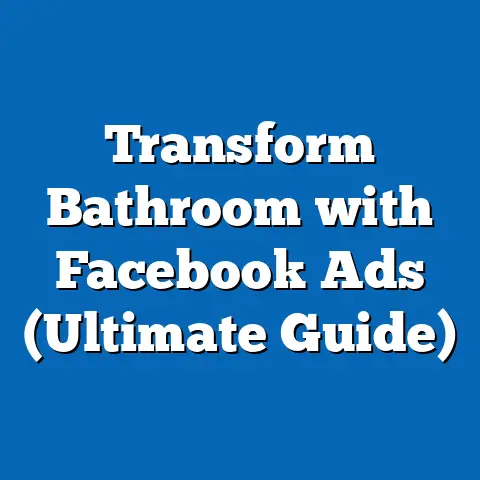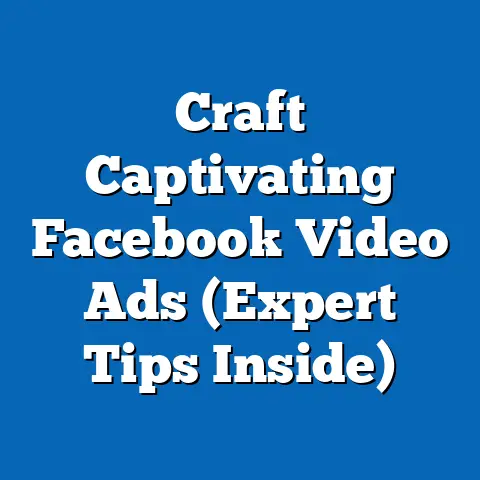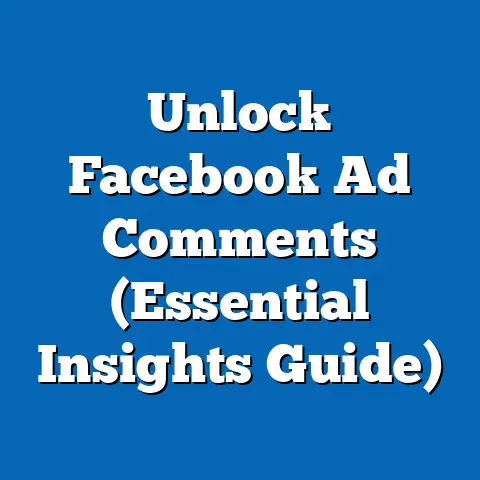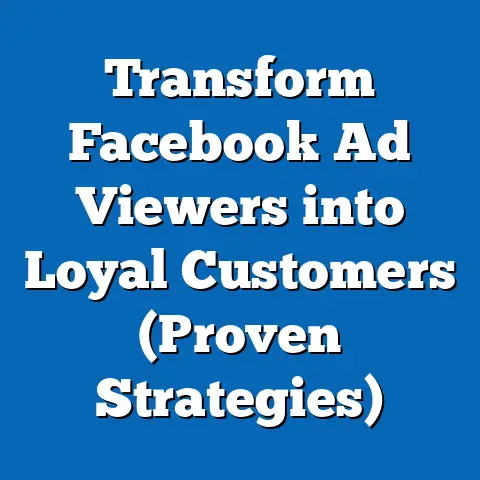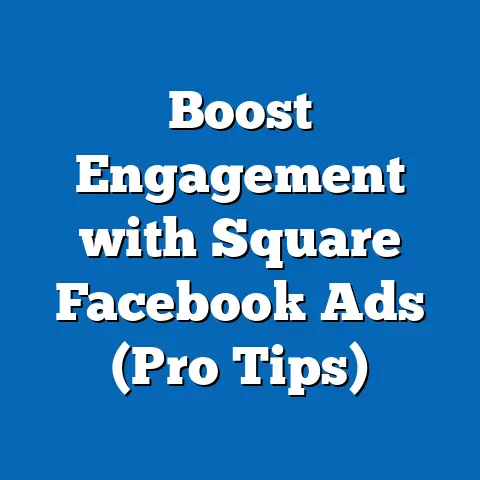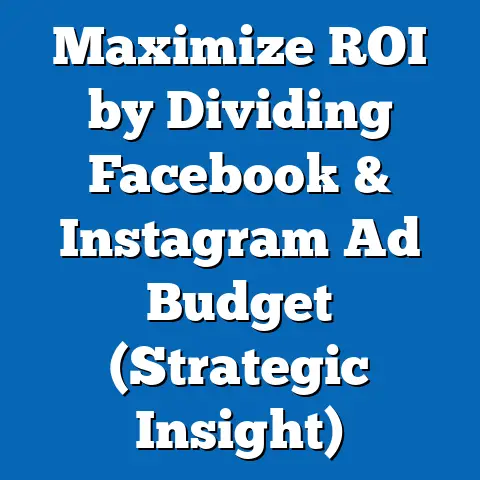Mastering Logo Design for Facebook Ads (Expert Tips Inside)
“A logo is just a small detail and doesn’t impact ad performance.” I’ve heard this sentiment echoed more times than I can count. And honestly, it’s a dangerous misconception. In the fast-paced, visually driven world of Facebook advertising, your logo isn’t just a pretty picture; it’s a vital piece of your brand identity that can make or break your campaign. Think of it as the digital handshake – the first impression you make on potential customers.
I’ve seen firsthand how a well-designed logo can boost engagement, brand recall, and ultimately, conversion rates. Imagine scrolling through your Facebook feed – a sea of ads vying for your attention. What makes you stop? Often, it’s a visually appealing image, and nestled within that image is a logo that either resonates or gets lost in the noise. A great logo isn’t just aesthetically pleasing; it communicates your brand’s values, builds trust, and differentiates you from the competition.
In this guide, I’m going to pull back the curtain on crafting killer logos specifically for Facebook ads. We’ll dive deep into the elements that make a logo effective, how to adapt your design for Facebook’s unique environment, and even share some insider tips from industry experts. Get ready to ditch the “small detail” mentality and start leveraging the power of logo design to supercharge your Facebook ad performance.
1. The Importance of Logo Design in Facebook Ads
Logos are more than just decorative elements; they are powerful tools that can significantly enhance your advertising efforts, particularly on social media platforms like Facebook. Think of your logo as the visual shorthand for your brand. It’s the symbol that instantly communicates who you are, what you do, and what you stand for.
I’ve often compared effective logo design to a strong handshake. It’s firm, memorable, and leaves a positive impression. In the context of Facebook ads, this impression is critical. Users scroll through their feeds at lightning speed, bombarded with information. Your ad has a mere fraction of a second to capture their attention. A well-designed logo can be the difference between a scroll-past and a click-through.
Let’s look at some statistics. Studies have consistently shown that ads with recognizable logos tend to have higher engagement rates. This isn’t just about aesthetics; it’s about building brand recall. When users repeatedly see your logo, they become more familiar with your brand, increasing the likelihood they’ll remember you when they need your product or service.
Consider this: a study by Lucidpress found that consistent brand presentation, including logo usage, can increase revenue by up to 23%. That’s a significant number! It highlights the tangible impact of investing in a strong, consistent brand identity.
Furthermore, logos contribute significantly to brand trust. In a world saturated with online scams and unreliable businesses, a professional-looking logo can signal legitimacy and trustworthiness. When users see a well-designed logo, they subconsciously perceive the brand as more credible and reliable. This trust is crucial for driving conversions, especially when you’re asking users to make a purchase or provide their personal information.
Key Takeaway: Your logo is not a minor detail; it’s a critical component of your Facebook advertising strategy. It contributes to brand recognition, trust, and ultimately, higher engagement and conversion rates.
2. Key Elements of Effective Logo Design for Ads
Designing a logo that resonates with your target audience and effectively communicates your brand message requires careful consideration of several key elements. I’ve found that the most successful logos share these common traits:
- Simplicity: A simple logo is easier to remember and recognize. Avoid cluttering your design with too many elements or complex details. Think of iconic logos like Nike’s swoosh or Apple’s bitten apple – instantly recognizable and incredibly simple.
- Relevance: Your logo should be relevant to your brand and the industry you operate in. It should communicate something about your products, services, or values. For example, a logo for a coffee shop might incorporate coffee beans or a steaming cup.
- Versatility: Your logo needs to look good in a variety of sizes and formats, from a tiny favicon on a website to a large banner on a billboard. Ensure your logo is scalable and legible in different contexts.
- Uniqueness: Your logo should be distinct and memorable, setting you apart from your competitors. Avoid using generic clip art or templates that can make your brand look unoriginal.
Beyond these fundamental components, color theory and typography play crucial roles in shaping the overall impact of your logo.
Color Theory: The Psychology of Colors
Colors evoke different emotions and associations, influencing consumer behavior in subtle but powerful ways. Understanding color psychology is essential for choosing colors that align with your brand personality and convey the right message.
For example:
- Blue: Often associated with trust, reliability, and security. It’s a popular choice for financial institutions and tech companies.
- Green: Represents nature, health, and growth. It’s commonly used by eco-friendly brands and businesses in the healthcare industry.
- Red: Evokes excitement, energy, and passion. It’s often used by brands that want to make a bold statement.
- Yellow: Represents happiness, optimism, and creativity. It’s commonly used by brands that want to project a cheerful and inviting image.
I’ve learned that it’s crucial to research the cultural associations of different colors, as their meanings can vary across different regions and demographics.
Typography: Choosing the Right Font
Typography is another critical element of logo design. The font you choose can significantly impact how your brand is perceived. Different fonts convey different personalities and messages.
For example:
- Serif fonts (like Times New Roman): Often associated with tradition, authority, and elegance.
- Sans-serif fonts (like Arial or Helvetica): Convey a modern, clean, and approachable feel.
- Script fonts: Can add a touch of sophistication and personality, but they can also be difficult to read in small sizes.
When choosing a font for your logo, consider your target audience and the overall message you want to convey. Make sure the font is legible in different sizes and formats, and that it complements the other elements of your logo.
Key Takeaway: A successful logo is simple, relevant, versatile, and unique. Pay close attention to color theory and typography to ensure your logo effectively communicates your brand message and resonates with your target audience.
3. Adapting Logo Design for Facebook’s Unique Environment
Facebook is a unique advertising environment with its own set of challenges and opportunities. To ensure your logo performs effectively on this platform, you need to adapt your design to suit Facebook’s specific ad formats and audience demographics.
One of the most important considerations is mobile optimization. The majority of Facebook users access the platform on their mobile devices. This means your logo needs to be clear and legible even on small screens. Avoid using overly intricate designs or tiny fonts that can become illegible on mobile devices.
I’ve found that simplicity is key when it comes to mobile logo design. Opt for a clean, uncluttered design that is easy to recognize at a glance. Consider using a simplified version of your logo for mobile ads, focusing on the most essential elements.
Another important factor to consider is Facebook’s audience demographics. Facebook has a diverse user base with varying interests and cultural backgrounds. Your logo should resonate with your target audience, taking into account their preferences and values.
I’ve seen brands successfully tailor their logo designs to specific demographics by incorporating cultural symbols, colors, or imagery that resonate with their target audience. However, it’s crucial to do your research and avoid using anything that could be considered offensive or insensitive.
Consistency is also paramount when it comes to logo design on Facebook. Your logo should be consistent across all your ad formats, from carousel ads to video ads. This helps build brand recognition and reinforces your brand identity.
However, consistency doesn’t mean rigidity. You may need to adapt your logo slightly to fit different ad formats. For example, you might need to adjust the size or placement of your logo to ensure it looks good in a video ad.
Key Takeaway: Adapt your logo design to suit Facebook’s unique environment by optimizing for mobile devices, considering audience demographics, and maintaining consistency across all ad formats.
4. Expert Tips for Designing Logos for Facebook Ads
Designing a logo that truly stands out in the crowded landscape of Facebook advertising requires more than just basic design principles. It demands a strategic approach, incorporating insights from industry experts and leveraging the power of data-driven decision-making.
Here are some actionable tips I’ve gathered from seasoned designers and marketing professionals:
- Conduct Competitor Analysis: Before you even start sketching, take a close look at your competitors’ logos. What works well? What doesn’t? What are the common themes and styles in your niche? This analysis can help you identify opportunities to differentiate your brand and create a logo that stands out from the crowd.
- Utilize Design Tools and Software: There are numerous design tools and software available, ranging from free online platforms to professional-grade applications like Adobe Illustrator. Experiment with different tools to find one that suits your skill level and budget. Don’t be afraid to explore tutorials and online courses to enhance your design skills.
- Gather Audience Feedback: Once you have a few logo variations, it’s time to get feedback from your target audience. Conduct surveys, run polls on social media, or even organize focus groups to gather insights on which logos resonate most effectively. Pay attention to both positive and negative feedback, and use it to refine your designs.
- Embrace A/B Testing: A/B testing is a powerful tool for optimizing your Facebook ad campaigns. Logos can be a focal point of such tests. Try running ads with different logo variations and tracking which ones generate the highest engagement and conversion rates. This data-driven approach can help you identify the most effective logo for your target audience.
- Consider Hiring a Professional Designer: If you’re not confident in your design skills, consider hiring a professional logo designer. A skilled designer can bring your brand vision to life and create a logo that is both aesthetically pleasing and strategically effective.
I’ve found that it’s often beneficial to collaborate with a designer, even if you have some design experience. A fresh perspective can help you identify potential weaknesses in your designs and create a logo that truly shines.
Key Takeaway: Incorporate expert tips into your logo design process by conducting competitor analysis, utilizing design tools, gathering audience feedback, embracing A/B testing, and considering hiring a professional designer.
5. Real-World Examples of Effective Logo Designs in Facebook Ads
To truly understand the principles of effective logo design for Facebook ads, let’s examine some real-world examples of brands that have successfully leveraged their logos to drive engagement and conversions.
Example 1: Airbnb
Airbnb’s logo, the “Bélo,” is a simple yet recognizable symbol that represents belonging and community. In their Facebook ads, Airbnb often incorporates the Bélo into visually appealing images of unique accommodations around the world. The logo is strategically placed to be visible without being intrusive, reinforcing brand recognition and creating a sense of trust.
Learning Point: Simplicity and relevance are key. Airbnb’s logo is easy to recognize and directly relates to their mission of connecting travelers with unique accommodations.
Example 2: Dollar Shave Club
Dollar Shave Club’s logo is a playful and memorable image of a dollar bill with a razor blade. In their Facebook ads, they often use their logo in conjunction with humorous and engaging copy, creating a brand personality that is both relatable and memorable.
Learning Point: Uniqueness and personality can go a long way. Dollar Shave Club’s logo is distinct and reflects their brand’s irreverent and humorous tone.
Example 3: Warby Parker
Warby Parker’s logo is a simple and elegant wordmark that reflects their brand’s commitment to quality and style. In their Facebook ads, they often use their logo in conjunction with visually stunning images of their eyewear, creating a sense of sophistication and aspiration.
Learning Point: Consistency and elegance can build trust. Warby Parker’s logo is consistently used across all their marketing materials, reinforcing their brand identity and conveying a sense of quality.
I’ve noticed a common thread among these successful brands: they all understand the importance of using their logos strategically to reinforce their brand identity and create a positive impression on potential customers.
Key Takeaway: Analyze real-world examples of effective logo designs in Facebook ads to identify key patterns and learn how to leverage your logo to drive engagement and conversions.
6. Common Mistakes to Avoid in Logo Design for Facebook Ads
Designing a logo that effectively represents your brand and resonates with your target audience requires careful planning and execution. However, many brands fall into common pitfalls that can undermine their logo’s effectiveness.
Here are some frequent mistakes I’ve observed in logo design for Facebook ads:
- Overcomplication: A logo that is too complex or cluttered can be difficult to recognize and remember. Avoid using too many elements, colors, or fonts. Keep your design simple and focused.
- Poor Scalability: Your logo needs to look good in a variety of sizes, from a tiny favicon to a large banner ad. Ensure your logo is scalable and legible in different contexts. Test your logo in different sizes to ensure it remains clear and recognizable.
- Neglecting Brand Identity: Your logo should reflect your brand’s personality, values, and mission. Avoid using generic designs or styles that don’t align with your brand identity. Take the time to define your brand identity before you start designing your logo.
- Using Low-Quality Images: A pixelated or blurry logo can make your brand look unprofessional and untrustworthy. Use high-resolution images and vector graphics to ensure your logo looks crisp and clear in all sizes.
- Ignoring Color Psychology: As discussed earlier, colors evoke different emotions and associations. Avoid using colors that clash with your brand personality or convey the wrong message. Research color psychology and choose colors that align with your brand values.
- Failing to Test and Iterate: Don’t assume your first logo design is perfect. Test different variations and gather feedback from your target audience. Use A/B testing to optimize your logo’s performance.
I’ve seen firsthand how these mistakes can negatively impact brand perception and ad performance. By avoiding these pitfalls, you can ensure your logo effectively represents your brand and drives positive results.
Key Takeaway: Avoid common mistakes in logo design for Facebook ads by keeping your design simple, ensuring scalability, reflecting your brand identity, using high-quality images, considering color psychology, and testing and iterating your designs.
Conclusion: The Path to Mastery in Logo Design for Facebook Ads
We’ve covered a lot of ground in this guide, from understanding the importance of logo design in Facebook ads to exploring expert tips and avoiding common pitfalls. I hope you now have a clearer understanding of how to craft a killer logo that resonates with your target audience and drives positive results.
Remember, your logo is more than just a pretty picture; it’s a vital piece of your brand identity that can make or break your Facebook ad campaigns. By investing time and effort into creating an effective logo, you can build brand recognition, increase trust, and ultimately, boost your engagement and conversion rates.
I encourage you to apply the expert tips and best practices shared throughout this article to elevate your own logo designs and improve your ad performance. Don’t be afraid to experiment, iterate, and seek feedback from your target audience.
The path to mastery in logo design for Facebook ads is a continuous journey of learning, experimentation, and refinement. By embracing this journey, you can unlock the full potential of your logo and achieve greater success in your Facebook advertising efforts.

